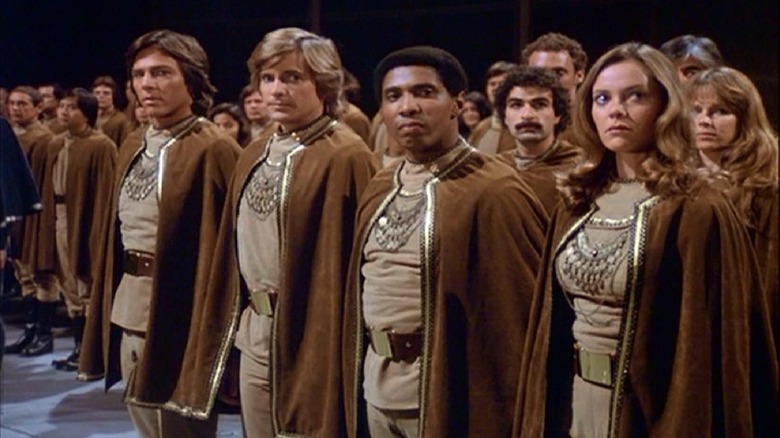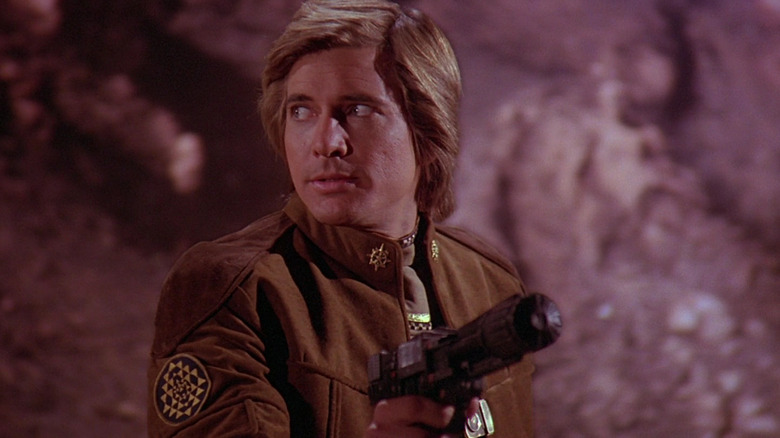Legendary Sci-Fi Writer Isaac Asimov Didn't Mince Words When It Came To Battlestar Galactica
Glen A. Larson's 1970s series "Battlestar Galactica" was a curious mix of high-end sci-fi and down-and-dirty pulp adventure. The premise was a little highfalutin. Set in an unspecified year in a very distant part of the galaxy, humans had been waging war with a species of intelligent robots called Cylons. The Cylons have gotten the drop on humanity and wiped out most of our species, leaving only a few scant human starships, led by the warship Battlestar Galactica, adrift in the heavens. Armed with a fleet of dogfighters, and with nowhere to go, the fleet searches the galaxy for a legendary lost planet of origin known as Earth.
As "Battlestar Galactica" fans could tell you, the single-season, 24-episode series ended with the characters finding Earth, but not in the way people expected. I shan't spoil the ending here.
At the same time, though, much of the show's appeal came from the high-speed dogfights between its hotshot human pilots and their sinister Cylon attackers. There was a pulp element to "Battlestar Galactica" that fans glommed onto, and this drove the bulk of the series. Indeed, "Battlestar Galactica" was unafraid to charge into battle, guns blazing. It also had whimsical elements, such as a daggit, a dog-like creature who lived among the humans.
Sci-fi fans also liked the headier elements of "Battlestar Galactica." This brings us to noted author and essayist Isaac Asimov, the author of "Foundation" (the basis for the Apple TV show of the same name), "I, Robot," and many works of sci-fi and literary criticism besides. Back in 1979, Asimov was interviewed by Southwest Airlines Magazine (archived on the AmericanIndian website), and the writer got to talk about his favorite sci-fi movies and TV shows of that era. As it turned out, he wasn't the biggest "Battlestar Galactica" fan.
Isaac Asimov wasn't the biggest fan of Battlestar Galactica
Asimov's objections came with the show's lack of scientific accuracy. Of course, Asimov was a sci-fi author himself, so he knew all about taking a few liberties with technology and physics in order to envision an imaginary future world. But with "Battlestar Galactica," Asimov objected to the way the ships flew around in space. He also didn't care for its similarities to "Star Wars" (much like George Lucas) and even admitted to hating Steven Spielberg's then-recent hit "Close Encounters of the Third Kind" for its scientific nonsense. As Asimov put it:
"Well, I liked 'Star Wars.' I thought 'Battlestar Galactica' was such a close imitation of 'Star Wars,' emphasizing the less attractive portions, that I was a little impatient with it. And as for 'Close Encounters,' I'm afraid I detested that. It was too noisy and parts of it were just silly. [...] 'Battlestar Galactica,' for instance, started off with 20 to 30 minutes of space battles which looked exactly like air battles in World War I. You could swear that the spaceships were surrounded by air, the way they maneuvered. One felt it was unworthy."
When asked what he thought of the small, fast-moving fighter jets in "Battlestar Galactica," known as Vipers, Asimov was frank, noting that their designs were retro to the point of being distracting. There's no way an advanced civilization, Asimov argued, would make ships that looked like that:
"It is as if people in the 1880s were writing fantasy stories about airplanes of the future, and they had the pilots lean back at the wheel and yell 'Whoa,' and the airplane came to a halt in midair."
That's the stuff of Westerns or combat pictures, not science fiction. Asimov wanted more creativity in his sci-fi.

